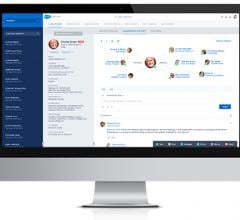If you enjoy this content, please share it with a colleague
RELATED CONTENT
December 21, 2021 — Oracle Corporation and Cerner Corporation jointly announced an agreement for Oracle to acquire ...
August 20, 2021 — Cerner Corporation announced that its Board of Directors has appointed David Feinberg, M.D., MBA, as ...
March 4, 2021 — Ambra Health announced the image-enablement of the Cerner EHR patient portal leading to enhanced interop ...
December 16, 2020 — Cerner Corporation announced an agreement to acquire Kantar Health, a division of Kantar Group, for ...
July 30, 2020 — Nuance Communications, Inc. announced that it has expanded its long-standing artificial intelligence (AI ...
A novel new study provides compelling evidence that the design, development and implementation of electronic health records (EHRs) need to be improved to make them easier to use by clinicians and, ultimately, safer for patients.
Cerner announced a new collaboration with Salesforce, a global leader in customer relationship management (CRM). Cerner is extending its population health, clinical and administration portfolio with an integrated solution that combines Salesforce Health Cloud and Marketing Cloud with Cerner’s HealtheIntent, its big data platform. Combined with Cerner’s data, analytic and application platform, electronic health record (EHR) and intelligent solutions, the addition of Health Cloud and Marketing Cloud will support enhanced consumer and provider engagement.
Cerner Corporation announced that Neal Patterson, chairman and CEO, passed away on July 9, 2017, due to unexpected complications that arose after a recent recurrence of a previously disclosed cancer. Cerner Co-Founder and Vice Chairman of the Board Cliff Illig has been named chairman and interim CEO.
During the first quarter of 2017, Black Book surveyed 140 chief information officers (CIOs), 159 chief financial officers (CFOs) and 448 hospital managers involved in planning and executing population health initiatives within the next 12 months. Ninety percent of the collective respondents revealed that future population health management (PHM) systems will essentially be projected to perform as next-generation patient accounting systems.
Organizations across the country — even globally — are taking a hard look at their imaging ecosystems and determining it is time for change. Most technology and clinical leaders have read, listened to and observed the imaging vendor narrative over the past few years while they focused primarily on deploying the electronic health records (HER). Now most feel comfortable enough — either internally or with the help of consultants — to tackle this next huge patient record initiative. Vendor neutral archives (VNA), viewers, workflow, analytics, integration and exchange are all under review as components of the enterprise imaging effort. The good news for those in this phase of discovery and analysis is that the pioneers are far enough down the path to prove that an enterprise approach can be incredibly successful and that there are organizational, clinical, technical and even financial benefits to adopting this model.


 December 21, 2021
December 21, 2021 








